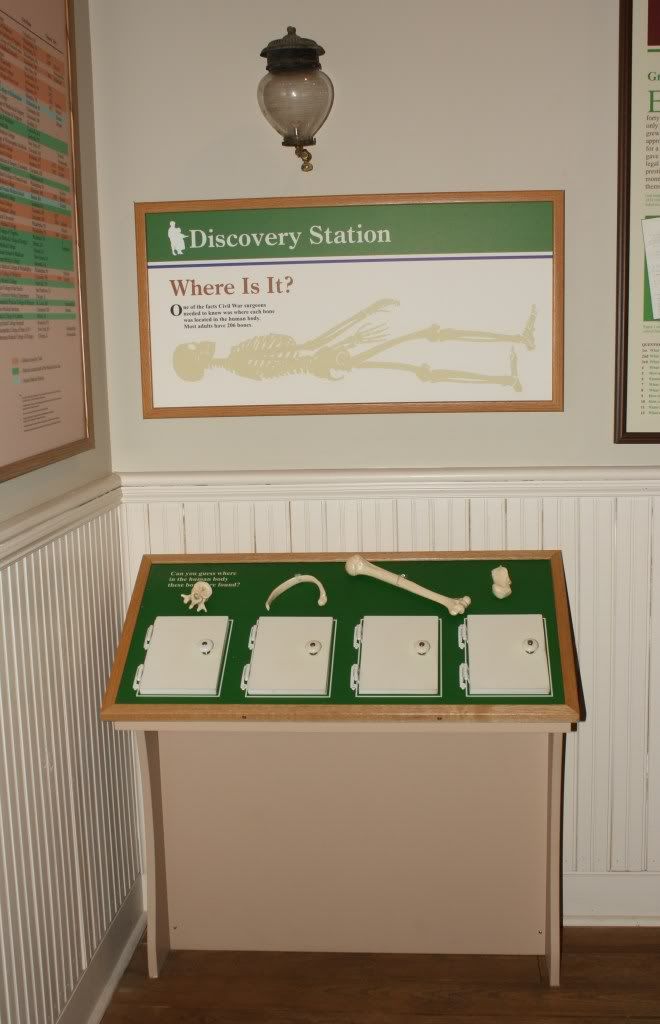Most times, museum visitors expect to be
reminded NOT to touch the items in the exhibits. In fact, many exhibits are designed so that
the items on display are protected from being handled. Artifacts are generally displayed inside
cases, or placed behind barriers.
However, there are some exhibits and displays which are meant to be
hands-on for the visitors. Of course,
these displays don’t contain artifacts, but they are still effective in
educating the museum’s visitors, especially the younger ones! Let’s take a look at some of these displays
in my museum.
 |
| The Discovery Stations at the NMCWM were designed with school children in mind, but we notice that adults like them too! This one provides an opportunity to identify some human bones. Don’t worry, these bones are reproductions! They are attached to the display with weighted ropes so that they remain in their proper positions, but so that visitors can pick them up to get a closer look. |
 |
| The answer and some additional information can be discovered by opening the door below each bone. |
 |
| Another type of hands-on display follows a Civil War soldier through the letters he wrote home. This is just the first of several displays located in the museum which follow the war experiences of Peleg Bradford as he served, and was wounded, in the war. Visitors can flip through reproductions of the letters he wrote home and read about what happened to him. |
 |
| In our Camp Life gallery, visitors can read cards which describe some of the drugs used during the Civil War. A similar display nearby has cards about some of the diseases commonly seen in the camps. |
 |
| This display panel introduces visitors to several Civil War surgeons. More information about each surgeon can be seen behind the doors. |
 |
| Behind this door it reads, “Surgeon William Proby Young, Jr., of Middletown, Maryland, first enlisted as a private in the 116th Virginia. After his one year enlistment ended, he appeared before the C.S. A. Army Medical Examining Board and received a commission as an assistant surgeon. Dr. Young was wounded during the Antietam Campaign of 1862, but returned to Virginia with his regiment. On June 9, 1863, he was promoted to Surgeon and transferred to hospital service.” Photo from A Band of Brothers, by Dan Hartzler. |
 |
| Another Discovery Station involves information about the horses and mules used in the Civil War. Each bucket here has a question about the feeding of horses and mules on the lid, with the answer printed beneath the lid. |
 |
| Do you think you know how much water a horse or mule would drink in a day? |
 |
| Were you right? |
 |
| It seems fitting to have a Discovery Station about children! There were more children who served in the Civil War than you might imagine. |
 |
| Here is Private Robert Fryer of the 52nd New York, who was one of many underage boys who claimed to be 18 in order to enlist. Boys between the ages of 14 to 17 could sign on as musicians. Some unofficial drummer boys were as young as 9 years old. Many young soldiers, such as Private Fryer, were wounded or killed while serving with their regiments. You can see in this photo that he lost part of his hand. Photo courtesy of the National Museum of Health and Medicine. |
 |
| This panel allows visitors to learn the stories of some of the wounded soldiers. |
 |
| Private Lewis Martin, Co. E, 29th United States Colored Troops, had his right arm and left foot amputated as a result of wounds sustained during the Battle of Petersburg, Virginia on July 30, 1864. This photo came from the National Archives. |
 |
| We certainly couldn’t leave out the Civil War nurses! |
 |
| Inspired by a plea for “ladies to go to the front to nurse the sick and wounded, “ Kate Cumming left her Mobile, AL, home to serve the Confederate soldiers. Her nursing career began in the hospitals of Corinth, MS, caring for the wounded from the two-day battle of Shiloh. Officially enrolled as a hospital matron, she served with distinction with the Medical Department of the Army of Tennessee throughout Mississippi, Tennessee, and Georgia. Cumming was one of the nurses involved with Dr. Samuel Stout’s mobile hospital system during the Georgia campaign. After the war she published her journal describing her experiences with hospital life in the Confederacy. This photo is from her book, Gleanings from Southland. |
 |
| Visitors can also read some of the wartime letters of another nurse, Clarissa Jones, in this display. Letters such as these give a deeper look into the feelings and experiences of the writer than an informational panel can. |
So, as you can see there are some times
when it is acceptable to touch the exhibits!
Photos courtesy of the National
Museum of Civil War Medicine, except where otherwise noted.
















No comments:
Post a Comment